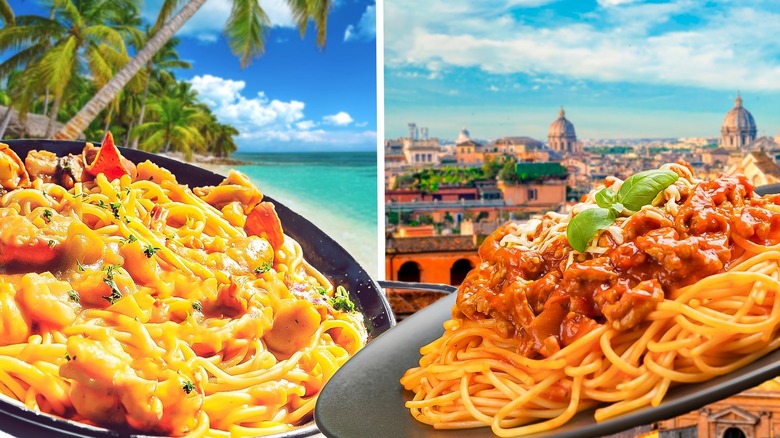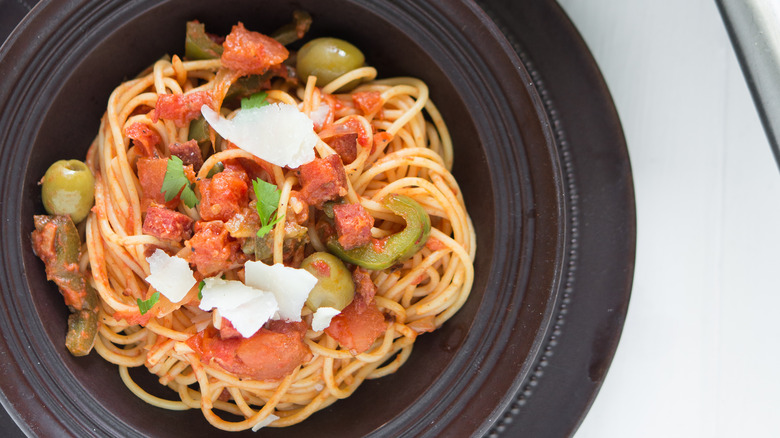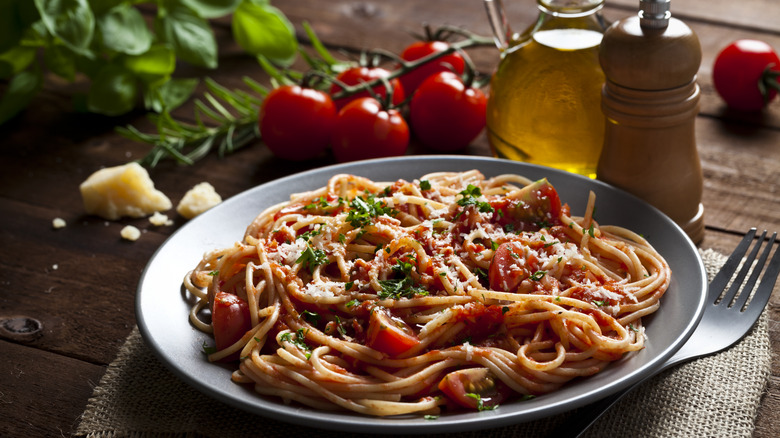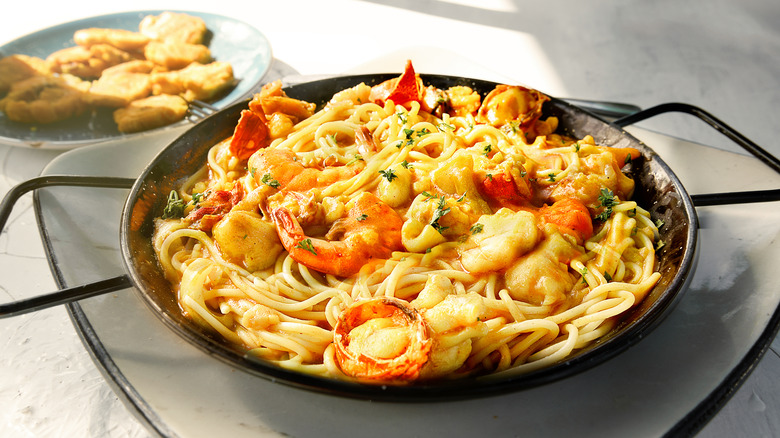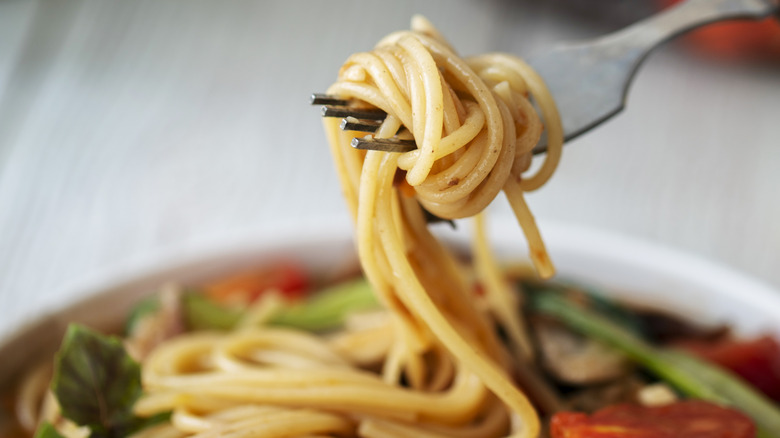Dominican Spaghetti Vs Italian: What's The Difference?
Pasta is a nomadic dish — first with noodle-like foods emerging in China, then spreading to Italy and beyond. Few types of doughy strands became quite as popular as spaghetti. After all, it's likely the type that comes to mind when pasta's mentioned. It's no surprise spaghetti is enjoyed far and wide, with many renditions across continents. The noodle variety is used in Japanese cuisine, and crafted into tasty dishes in Peru. And spaghetti is a part of Caribbean cuisine frequently enjoyed in the Dominican Republic.
The noodles were first brought to the island by Italian immigrants in the 19th century. However, it's the opening of a factory in the Dominican Republic that popularized spaghetti into a national classic. Esteemed for its affordability, a variety of renditions arose, each with its own distinct spin. Backed by such a rich history, it's no surprise the food is so different from its Italian predecessor. Let's dive into the details.
What is Dominican spaghetti?
In the Dominican Republic, pasta is often enjoyed as a picnic food, especially at the beach. It's known as empaguetada, an easy-going and comforting dish open to malleable ingredient additions. A familiar trio of onions, garlic, and tomato sauce is a frequent base, although it's often expanded with peppers, annatto, olives, and varying proteins, such as chicken, cured meats, and even pork chops. For an added creamy finish and a bit of sugar, many pour in a can of evaporated milk. And since the dish is consumed hours after it's prepared, the pasta is typically a little overcooked and heavily seasoned so that it can be enjoyed at room temperature.
To accompany this, hefty carbs like rice, bread, or plantain fritters called tostones are served alongside the dish. Popular local breads such as pan sobao and pan de agua can even function as sandwich vessels with the fragrant pasta filling inside. Each rendition of the dish crafts unique flavoring and sides, yielding no two Dominican spaghetti alike.
What is Italian spaghetti?
Spaghetti-like foods have been enjoyed in the Mediterranean for centuries with origins in Ancient Greece. Likely first introduced to Sicily, spaghetti didn't become widely popular in Italy until the 19th century. It was around this time that tomatoes became embraced by the New World, and the iconic combination emerged. Today, Italian spaghetti is classically enjoyed alongside a simmered garlic sauce — in a dish called aglio e olio — and paired with seafood. Spaghetti and meatballs were first created in the U.S., so it's not a rendition of Italian spaghetti.
More definitively than its accompaniments is the pasta's texture; it's consistently prepared al dente. Traditionally, it's served as a second course — before a main meat dish — rather than being the star of the meal. As a result, its portion is smaller, and the flavor is more concentrated in the sauce; hence, there is a lack of meaty accompaniments. Yet, when perfectly balanced, varieties of Italian spaghetti are aromatic pasta dishes at their best.
Dominican spaghetti integrates more ingredients than the Italian variety
Italian pasta dishes are kept simple yet flavorful with a limited number of ingredients. The volume of sauce is kept light, and the texture of the pasta is an important aspect of the dish. While each chef may fine-tune the dish's nuances, most versions are delineated into classic recipes like carbonara or aglio e olio.
Conversely, Dominican spaghetti is loaded with flavorful components, incorporating a wide range of aromatics, various meats, and vegetables. The sauce especially utilizes many elements, melding sofrito with ingredients like olives, bouillon cubes, and oregano, all softened with condensed milk. Most don't rely on fresh tomatoes; rather, they use a combination of tomato paste and sauce to achieve the food's iconic red color. And as opposed to Italian spaghetti, meat additions are common, whether it's cured products like salami, pork chops, or chicken. To amplify its textural variance, the noodles are often crumbled before boiling. Such a preparation style yields a bold pasta dish that seldom lacks flavor.
Dominican and Italian spaghetti are consumed in different contexts
Dominican spaghetti is prepared for convivial settings, a cost-effective food meant to be shared. It's crafted in very large batches, and it isn't uncommon for preparation to involve three or four boxes of spaghetti. Its flavorful delights are consumed casually, divided among paper plates, and eaten with plastic forks. Along with its sides, Dominican spaghetti is a filling meal made for an outdoor weekend with family and friends.
Meanwhile, in Italy, spaghetti takes less of a center stage, instead being a smaller portion among other courses. It's most often eaten for lunch, which is the largest meal of the day. Therefore, it's not made in large quantities and with filling components, instead of a vessel for a tasty noodle and sauce. When eating out at restaurants, pasta dishes are not ordered to be shared, but rather prepared in individual portions. Therefore, Italian spaghetti most frequently appears as a delicious bite during an elaborate lunch rather than fulfilling a centerpiece role.
